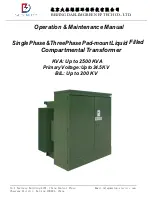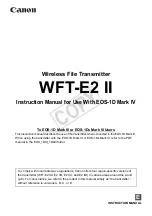
Instruction Manual
OCM F
page 96
OCM F - rev. 05 / 06.04.2018
Verification of the Measurement System
26
General
The verification of the measurement system should be carried out by the NIVUS service if
possible or by an expert company authorised by NIVUS.
In case of an initial general verification carried out by hydraulically and technically
well-versed personnel, proceed according to the guidelines described below:
•
Check power supply on the OCM F. The according slide switch on the board must be
engaged (see Fig. 14-12). The main screen must be visible on the transmitter display.
•
Check the communication between flow velocity sensor or combi sensor and transmitter
at >I/O< / >Doppler-Info<.
•
If the sensor(s) is/are not recognised, check the connections as well as overvoltage pro-
tection elements which might have been used.
•
Check the level measurement
•
Check the flow velocity measurement
•
Check analog and digital inputs and outputs (see chapter „24.1 I/O submenu “Digital In-
puts”“, “24.2 I/O submenu “Analog Outputs”” and chapter “27 Verification of Combi
Sensor with Pressure Measurement Cell” and “28 Verification of external Level Meas-
urement“).
For initial assessment mainly the I/O menu is helpful. Refer to chapter “Troubleshooting”
starting at page 92 to locate the most prominent errors.
27
Verification of Combi Sensor with Pressure Measurement Cell
Due to physical reasons, the level measurement using sensors with pressure measurement
cell is subject to long-term drift (see „Technical Instructions of Doppler sensors“). NIVUS
therefore recommend to calibrate sensors with integrated pressure measurement cells twice
per year regarding the zero point. The best calibration results can be achieved if the water
level is as low as possible or by dismantling and removing the sensors from the measure-
ment medium.
The calibration procedure is described in chapter “25 Calibration and Calculation Menu
(CAL)“.
Measurement errors
Adjusting the zero point by measuring the current filling level with a yardstick, a ruler or
similar in the flowing medium is tending to errors. As soon as the ruler (or yardstick) is be-
ing put into the flowing water the resulting surge will lead to measurement errors depending
on the current flow velocity.
This is why the filling level for reference measurement purposes has to be measured al-
ways from top down!
Summary of Contents for OCM F
Page 105: ...Approvals and Certificates OCM F rev 05 06 04 2018 page 105 Approvals and Certificates...
Page 106: ...Instruction Manual OCM F page 106 OCM F rev 05 06 04 2018...
Page 107: ...Approvals and Certificates OCM F rev 05 06 04 2018 page 107...
Page 108: ...Instruction Manual OCM F page 108 OCM F rev 05 06 04 2018...
Page 109: ...Approvals and Certificates OCM F rev 05 06 04 2018 page 109...
Page 110: ...Instruction Manual OCM F page 110 OCM F rev 05 06 04 2018...















































